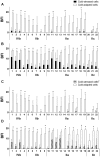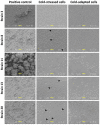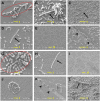Increased Adhesion of Listeria monocytogenes Strains to Abiotic Surfaces under Cold Stress
- PMID: 29187836
- PMCID: PMC5695204
- DOI: 10.3389/fmicb.2017.02221
Increased Adhesion of Listeria monocytogenes Strains to Abiotic Surfaces under Cold Stress
Abstract
Food contamination by Listeria monocytogenes remains a major concern for some food processing chains, particularly for ready-to-eat foods, including processed foods. Bacterial adhesion on both biotic and abiotic surfaces is a source of contamination by pathogens that have become more tolerant or even persistent in food processing environments, including in the presence of adverse conditions such as cold and dehydration. The most distinct challenge that bacteria confront upon entry into food processing environments is the sudden downshift in temperature, and the resulting phenotypic effects are of interest. Crystal violet staining and the BioFilm Ring Test® were applied to assess the adhesion and biofilm formation of 22 listerial strains from different serogroups and origins under cold-stressed and cold-adapted conditions. The physicochemical properties of the bacterial surface were studied using the microbial adhesion to solvent technique. Scanning electron microscopy was performed to visualize cell morphology and biofilm structure. The results showed that adhesion to stainless-steel and polystyrene was increased by cold stress, whereas cold-adapted cells remained primarily in planktonic form. Bacterial cell surfaces exhibited electron-donating properties regardless of incubation temperature and became more hydrophilic as temperature decreased from 37 to 4°C. Moreover, the adhesion of cells grown at 4°C correlated with affinity for ethyl acetate, indicating the role of cell surface properties in adhesion.
Keywords: BRT®; Listeria monocytogenes; MATS; SEM; adhesion; biofilm; cold stress; crystal violet staining.
Figures







Similar articles
-
Variability of Listeria monocytogenes strains in biofilm formation on stainless steel and polystyrene materials and resistance to peracetic acid and quaternary ammonium compounds.Int J Food Microbiol. 2016 Nov 21;237:164-171. doi: 10.1016/j.ijfoodmicro.2016.08.029. Epub 2016 Aug 23. Int J Food Microbiol. 2016. PMID: 27585076
-
Influence of temperature on biofilm formation by Listeria monocytogenes on various food-contact surfaces: relationship with motility and cell surface hydrophobicity.J Appl Microbiol. 2008 Jun;104(6):1552-61. doi: 10.1111/j.1365-2672.2007.03688.x. Epub 2008 Jan 9. J Appl Microbiol. 2008. PMID: 18194252
-
Morphological Change and Decreasing Transfer Rate of Biofilm-Featured Listeria monocytogenes EGDe.J Food Prot. 2017 Mar;80(3):368-375. doi: 10.4315/0362-028X.JFP-16-226. J Food Prot. 2017. PMID: 28199146
-
Evaluation of anti-Listeria meat borne Lactobacillus for biofilm formation on selected abiotic surfaces.Meat Sci. 2014 Jan;96(1):295-303. doi: 10.1016/j.meatsci.2013.07.010. Epub 2013 Jul 18. Meat Sci. 2014. PMID: 23933630
-
Micro/nanoencapsulation strategy to improve the efficiency of natural antimicrobials against Listeria monocytogenes in food products.Crit Rev Food Sci Nutr. 2021;61(8):1241-1259. doi: 10.1080/10408398.2020.1755950. Epub 2020 Apr 23. Crit Rev Food Sci Nutr. 2021. PMID: 32323558 Review.
Cited by
-
Bacterial diversity and geomicrobiology of Winter Wonderland ice cave, Utah, USA.Microbiologyopen. 2024 Aug;13(4):e1426. doi: 10.1002/mbo3.1426. Microbiologyopen. 2024. PMID: 38995161 Free PMC article.
-
Bioactivity of Essential Oils for Mitigation of Listeria monocytogenes Isolated from Fresh Retail Chicken Meat.Foods. 2021 Dec 4;10(12):3006. doi: 10.3390/foods10123006. Foods. 2021. PMID: 34945555 Free PMC article.
-
Anti-adherence Activity of Monomicrobial and Polymicrobial Food-Derived Enterococcus spp. Biofilms Against Pathogenic Bacteria.Curr Microbiol. 2023 May 18;80(7):216. doi: 10.1007/s00284-023-03326-9. Curr Microbiol. 2023. PMID: 37198525
-
Free-Living, Psychrotrophic Bacteria of the Genus Psychrobacter Are Descendants of Pathobionts.mSystems. 2021 Apr 13;6(2):e00258-21. doi: 10.1128/mSystems.00258-21. mSystems. 2021. PMID: 33850039 Free PMC article.
-
Disinfectant Susceptibility of Biofilm Formed by Listeria monocytogenes under Selected Environmental Conditions.Microorganisms. 2019 Aug 21;7(9):280. doi: 10.3390/microorganisms7090280. Microorganisms. 2019. PMID: 31438656 Free PMC article.
References
-
- Bellon-Fontaine M.-N., Rault J., van Oss C. J. (1996). Microbial adhesion to solvents: a novel method to determine the electron-donor/electron-acceptor or Lewis acid-base properties of microbial cells. Colloids Surf. B Biointerfaces 7 47–53. 10.1016/0927-7765(96)01272-6 - DOI
LinkOut - more resources
Full Text Sources
Other Literature Sources

